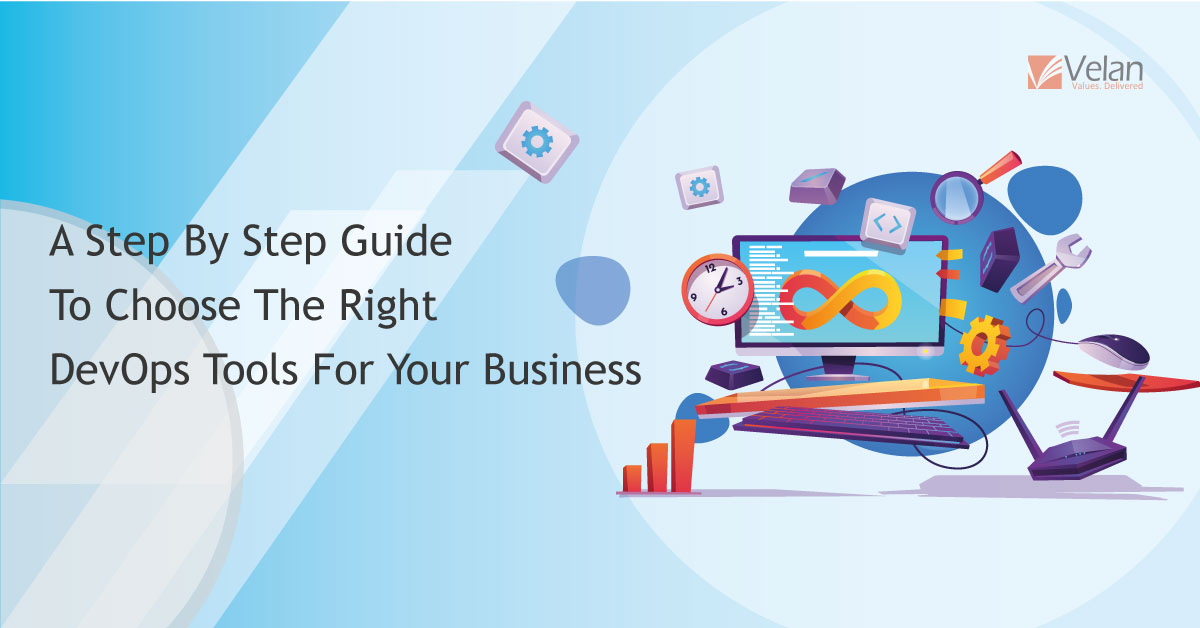A Step By Step Guide To Choose The Right DevOps Tools For Your Business 19 Nov 2020

DevOps has been a major influence, and it is continuously growing in demand in software development and deployment. It has revolutionized the software development life cycle process for good.
DevOps is the cross-pollination of two teams – Development and Operations – that works together to deliver outstanding results in a quicker turnaround time. It is a process that combines software development with information technology operations whose goal is to reduce the development time and provide continuous delivery with high quality.
DevOps is lean thinking combined with agile philosophy. Agile development reinforces evolutionary development, early delivery, adaptive planning, and continual improvement. It supports a flexible and rapid response to change.
But how will you implement this effectively?
What are the steps to choosing the right DevOps tools?
7 steps to choosing the right DevOps tools
Step #1: Settle on a common strategy that will reflect your business goals.
DevOps teams must design a common strategy that will encourage collaboration between development, testing, and infrastructure automation teams. It means the teams should settle on a middle ground that will encourage them to complete their work together.
The objective to keep in mind is that the tools selected by the different teams must include and foster one thing in mind – DevOps!
- Processes
- Communications and collaboration planning
- Continuous development tools
- Continuous integration tools
- Continuous testing tools
- Continuous deployment tools
- Continuous operations and CloudOps tools
The tools you select as a team must enable you to work together on your business objectives for DevOps while strengthening internal communication, collaboration, and oneness. A common DevOps tools strategy must adhere to a common business objective to provide continuous collaboration and integration between tools.
The goal is to automate every process: the developers must be able to update and send new codes, test in a shared environment, keep the process transparent without others losing track of the progress of the project.
Step #2: DevOps tools must record every requirement.
The purpose of DevOps tools is to keep the whole software development life cycle transparent. And this means no ad hoc requirements or changes to the software must happen outside the DevOps tools. Every request must be recorded on the tools you decide within the team.
Let us remind you that capturing a new requirement for the software is different from recording software development progress.
For example, to fit a new tax model for the business, you are changing software, or to boost the database access module’s performance, you are changing the software to house a request.
Step #3: Embrace the Kanban project management method.
Kanban is an agile workflow management method that focuses on getting things done and leads towards the successful completion of that task. It is the process to design, manage, and enhance flow systems for knowledge work.
Kanban process enables organizations to start anytime with their existing project workflow, unlike other project management methods, and drives towards evolutionary change. It gives teams more flexible planning and working options, limits work in progress, clears focus, keeps the development cycle more transparent, and helps to balance the work evenly.
Kanban tools in DevOps gives you the potential to visualize what you can do and everything related to it. It confronts the human ability to oppose change. It helps to balance the workflow methods so that you do not carry or attempt to complete everything at once. Kanban tools encourage continuous flow, meaning when you complete one task, the next task that has been in the backlog for the longest makes its way to the development.
Step #4: DevOps tools must record your productivity.
When you select your DevOps tools, keep in mind that the tools must have the potential to understand your DevOps processes’ productivity, both manual and automated, and also gauge if the tools will work in your favor.
The tools must also enable you to
- Define the metrics that are related to DevOps processes like project completion to deployment versus identifying errors during testing.
- Define automated processes to rectify issues without involving humans.
Step #5: Implement automated testing and evaluate data provisioning tooling.
Test automation is the process of running tests automatically, data handling, and deploying the results to enhance the quality of the software. The focus is more towards a quality assurance measure, however, its activities entail the entire software production team’s responsibility and commitment.
DevOps tools must enable testing to be a continuous process. Tossing code and data or running automated tests means that you must place the code in your testing environment, assign it to the application, and run thousands of tests, which after completion should automatically decide where to land – if the test remains successful, then it should make way to the next DevOps process or if there is an error, it should automatically fall back to the developer’s room for rework.
Step #6: Test every tool for DevOps before implementation.
The tools that you use for your DevOps process should be accepted unanimously by all the stakeholders. And so you must test the tools with every team by involving all its functions, including the test environment you will use. Define the criteria your tools must achieve in every team and ensure the tools can redefine requirements when needed in the future. Because as applications and new software requirements evolve, you might want to stretch the ability of your DevOps tooling too.
Step #7: Focus on discussing the tools’ performance and get continuous feedback from all the stakeholders of the tools.
DevOps tools might get difficult to handle when there is a lack of communication between the teams. After all, the whole concept of DevOps is to connect the teams that are in siloes and bring them together to work together on the common business objective.
So, there is no better option than getting continuous feedback between the process. The right tool will help you identify the problems between tests and tag the issues with the proof for the teams to comprehend. The right tool will give a complete analysis and the root cause of the problem so the teams can directly discuss the cause of the issue and settle it. The tool must help you give constructive feedback.
With such an approach, you will be able to maintain oneness in the team, seamless communication, and together find a solution to the problem. With continuous feedback, you will be able to lead your project towards completion and push it to production sooner. And again, get on to the feedback loop to check the purpose of the tooling.
DevOps tools categories
There are a lot of DevOps tools that you can implement for your business process. However, the tools we have listed below will by default be needed.
And other tools that you choose could be based on the distinct business functions and categories that you serve.
The most important tool categories include:
- Version control: It is related to change management. The tools track the software versions, configuration, testing dependencies, operating system details, server requirements, and database’s type, brand, and version, operating system as they are released.
- Build and deploy: The tools will automate the process of creating and deploying the software throughout the DevOps process. It also included continuous development and continuous integration.
- Functional and non-functional testing: The tools provide automated testing, along with all the best practices mentioned above. Testing tools must offer integrated unit, performance, and security testing services to serve the purpose of end-to-end automation.
- Provisioning and change management: The tools to provision the platforms are needed for software deployment, monitor and record every change in the configuration, data, or the software. These tools make sure to revert the system to a stable state.
Summary
Accepting DevOps into your business process is quite a task, and so it requires you to be fully involved in choosing the right tools. The tools selection matters a lot as they are bound to transform the whole business operations towards betterment and automate them. Being efficient during the whole adoption process is mandatory and to be that, you need to be informed about every move you make.
To ease your DevOps adoption, you can choose the best DevOps consulting services, like Velan, who can make the entire work seamless for you. Our DevOps consultants and experts will help you understand the different tools available and handhold you in selecting the best tools that will prove efficient for your business, ultimately, it will lead you to the success of your software development project.





